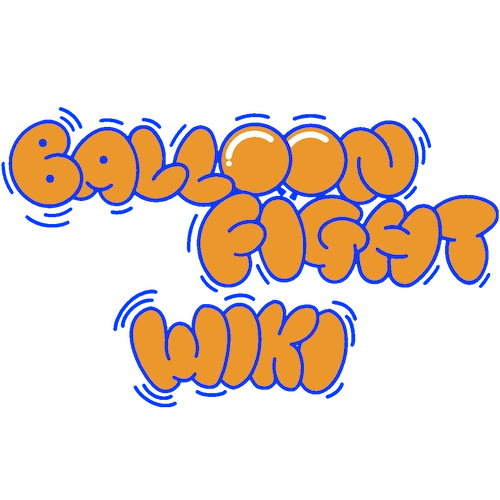Balloon Trip is a recurring game mode in the Balloon Fight franchise, first introduced in Balloon Fight on the NES. The goal in this style of gameplay is often to survive for as long as possible while collecting Balloons for points.
Balloon Fight (NES)[]
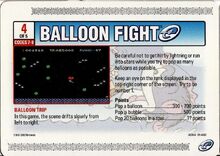
The 4th Balloon Fight-e card, explaining Balloon Trip
In Balloon Fight for the NES, Balloon Trip is the third game mode. Unlike the main two modes, it has no Balloon Birds to defeat, nor any platforms other than the temporary one at the start.
The Balloons start out green and are worth 300 points. Popping twenty in a row without letting any pass will upgrade the Balloons, first to orange and then to red, being worth 500 and 700 points respectively. Unlike later installments, Balloons do not revert back to normal if one goes off screen. In addition to getting points from Balloons, the player also gains 10 points for every half of a second that they survive.
The mode starts out with a preset obstacle course made out of stationary Sparks and Balloons. After that, Sparks and Balloons are randomly placed, with Sparks moving vertically at various speeds. Periodically, breaks in the Sparks will appear giving the player time to rest before the next section starts. Giant Bubbles will float up out of the sea occasionally, and popping them gives the player 500 points and stops the screen from scrolling temporarily.
For as long as the game is on, all of the player's attempts are recorded in an invisible leaderboard. The rank displayed in the top-right of the screen states what place the player is currently in on that leaderboard. When the game is first powered on, the places on this leaderboard are set to the scores 500 through 25,000 in increments of 500 points. Since the game's cartridge doesn't have any way to save these scores, they are erased when the game is turned off or reset. However, through the Virtual Console releases on the Wii, 3DS, and Wii U, these scores will be recorded even after closing the game because of the suspend point feature.
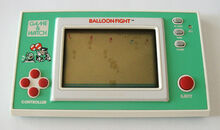
The system itself
Balloon Fight (Game & Watch)[]
- Main article: Balloon Fight (G&W)
The entire game follows the formula of Balloon Trip from the NES version, with some notable additions. Unlike the continuous, randomly generated patterns of the NES game, this version has eighteen distinct phases, which each have either pre-set or random patterns that loop until the player progresses. In order to advance to the next phase, the player must collect 25 Balloons, after which the player is given an opportunity to warp to a Bonus Stage. After every eight phases, the player fights Oiram Repus. The player is also able to earn extra lives and land on islands which scroll past.

Balloon Kid[]
- Main article: Balloon Kid
While the game's main mode largely follows the formula of Balloon Trip, there is also the option to play a recreation of the original NES game mode.
The main game makes many changes to the NES version, such as having a finite number of defined stages. These stages are designed more similarly to a standard platformer level than to the aerial obstacle courses seen previously, seen most clearly by the comparatively sparse use of water in earlier stages such as Pencilvania and the Forest. Beyond just Sparks, these stages also feature a variety of enemies both in the air and on the ground, as well as boss fights in every other stage.
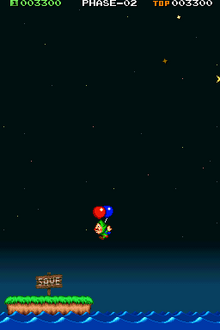
A checkpoint island, with the sign visible
Tingle's Balloon Fight DS[]
While Tingle's Balloon Fight DS is largely just a remake of the original NES version, the Balloon Trip mode has some minor improvements upon the original.
Similar to the Game & Watch game, the trip is split into phases. These phases, unlike the original, are largely pre-set. Between each phase, a small island with a "save" sign appears. As soon as the sign is visible, the game saves your progress and then allows you to return to that point at any time from the main menu.
The first phase is a recreation of the beginning of the NES version, but starting with Phase 3 the layouts are unique to this game.
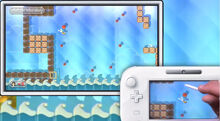
Screenshot from the trailer of Nintendo Land
Balloon Trip Breeze[]
- Main article: Balloon Trip Breeze
Much like Balloon Kid, the Balloon Trip Breeze minigame in Nintendo Land takes the formula of the original Balloon Trip mode and adds many new elements. The gameplay is segmented into four times of day, for six days and a morning.
This game introduces a unique control scheme utilizing the Wii U Gamepad's touchscreen, where the player must slide across the screen to make gusts of wind that carry their Mii around the stage.
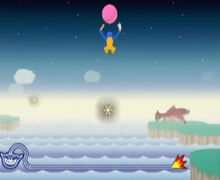
The WarioWare: Smooth Moves microgame
WarioWare[]
The WarioWare series has consistently included Balloon Fight-related microgames, starting with the first release on the Game Boy Advance. Of these, several have been short recreations of Balloon Trip.
WarioWare, Inc.: Mega Microgame$!, the series' debut title, featured a microgame where the player had to survive a brief segment of Balloon Trip.
WarioWare: Smooth Moves also featured a 3D recreation of the original mode, in which you fly as the Balloon Fighter and try to avoid Sparks, Balloon Birds, and the Balloon Fish. The game includes both a short microgame version which appears at random during 9-Volt and 18-Volt's stage as well as an infinite minigame which gives the player the ability to also steer left and right by splitting the controls across the Wii Remote and Nunchuk. The minigame version also features Balloons and periodic breaks. The design for the characters used here is more in line with the surreal art style of the rest of the game, making the Balloon Fighter and Balloon Birds proportionally accurate and giving more detail to the Fish, who is now bright red. The Balloon Fighter's clothing and Balloon matches the colors seen on the Famicom box art in the microgame, but is modeled after the in-game palette for the minigame.
WarioWare D.I.Y. Showcase also featured a fully playable Balloon Trip minigame as a way to play both pre-made and custom-made songs. In this mode, the player controlled the maestro from the DS version dressed as the Balloon Fighter, and could fly to collect the notes and make them play. Unlike all other instances of Balloon Trip, this game mode has the screen scrolling from left to right.
Trivia[]
- According to an interview with Yoshio Sakamoto, the designer for the NES game, Balloon Trip mode was actually created in the last three days of the game's development by Satoru Iwata, at the request of Gunpei Yokoi.[1]
- The absolute minimum of points you can get is 50. Without hitting a spark, if you hit left or right immediately upon starting, you can get a score of 70, but if you hit the first spark that appears quickly enough, you can get as low a score as 50.[2]
- In Balloon Fight-e, the card info calls the stationary Sparks seen in the beginning "Stars".
- Vs. Balloon Fight is the only game in the franchise which doesn't have this mode in any form.
References[]
| Stages | |||||||||||||||||||||||||||||||||||||||||||||||||||||||||||||||||||||||||||||||||||||||||
|---|---|---|---|---|---|---|---|---|---|---|---|---|---|---|---|---|---|---|---|---|---|---|---|---|---|---|---|---|---|---|---|---|---|---|---|---|---|---|---|---|---|---|---|---|---|---|---|---|---|---|---|---|---|---|---|---|---|---|---|---|---|---|---|---|---|---|---|---|---|---|---|---|---|---|---|---|---|---|---|---|---|---|---|---|---|---|---|---|---|
| Common | Balloon Trip - Bonus Stage | ||||||||||||||||||||||||||||||||||||||||||||||||||||||||||||||||||||||||||||||||||||||||
| Vs. Balloon Fight | Green | Orange | Turquoise | Blue | Yellow | ||||||||||||||||||||||||||||||||||||||||||||||||||||||||||||||||||||||||||||||||||||
| 1 - 2 - 3 | 4 - 5 - 6 | 7 - 8 - 9 | 10 - 11 - 12 | 13 - 14 - 15 | |||||||||||||||||||||||||||||||||||||||||||||||||||||||||||||||||||||||||||||||||||||
| 16 - 17 - 18 | 19 - 20 - 21 | 22 - 23 - 24 | 25 - 26 - 27 | 28 - 29 - 30 | |||||||||||||||||||||||||||||||||||||||||||||||||||||||||||||||||||||||||||||||||||||
| Demo | |||||||||||||||||||||||||||||||||||||||||||||||||||||||||||||||||||||||||||||||||||||||||
| NES | Green | Red | Blue-Green | Blue | |||||||||||||||||||||||||||||||||||||||||||||||||||||||||||||||||||||||||||||||||||||
| 1 - 2 - 3 | 4 - 5 - 6 | 7 - 8 - 9 | 10 - 11 - 12 | ||||||||||||||||||||||||||||||||||||||||||||||||||||||||||||||||||||||||||||||||||||||
| Game & Watch | Phase 1 - 2 - 3 - 4 - 5 - 6 - 7 - 8 - 9 - 10 - 11 - 12 - 13 - 14 - 15 - 16 | ||||||||||||||||||||||||||||||||||||||||||||||||||||||||||||||||||||||||||||||||||||||||
| Balloon Kid/Balloon Fight GB | Vs. Stage - Pencilvania - Forest - Sea A - Whale - Sea B - Northern Sea - Cave - Secret Base | ||||||||||||||||||||||||||||||||||||||||||||||||||||||||||||||||||||||||||||||||||||||||
| Balloon Trip Breeze |
| ||||||||||||||||||||||||||||||||||||||||||||||||||||||||||||||||||||||||||||||||||||||||
| Morning | Tutorial | 4 | 8 | 12 | 16 | 20 | 24 | ||||||||||||||||||||||||||||||||||||||||||||||||||||||||||||||||||||||||||||||||||
| Afternoon | 1 | 5 | 9 | 13 | 17 | 21 | |||||||||||||||||||||||||||||||||||||||||||||||||||||||||||||||||||||||||||||||||||
| Evening | 2 | 6 | 10 | 14 | 18 | 22 | |||||||||||||||||||||||||||||||||||||||||||||||||||||||||||||||||||||||||||||||||||
| Night | 3 | 7 | 11 | 15 | 19 | 23 | |||||||||||||||||||||||||||||||||||||||||||||||||||||||||||||||||||||||||||||||||||
